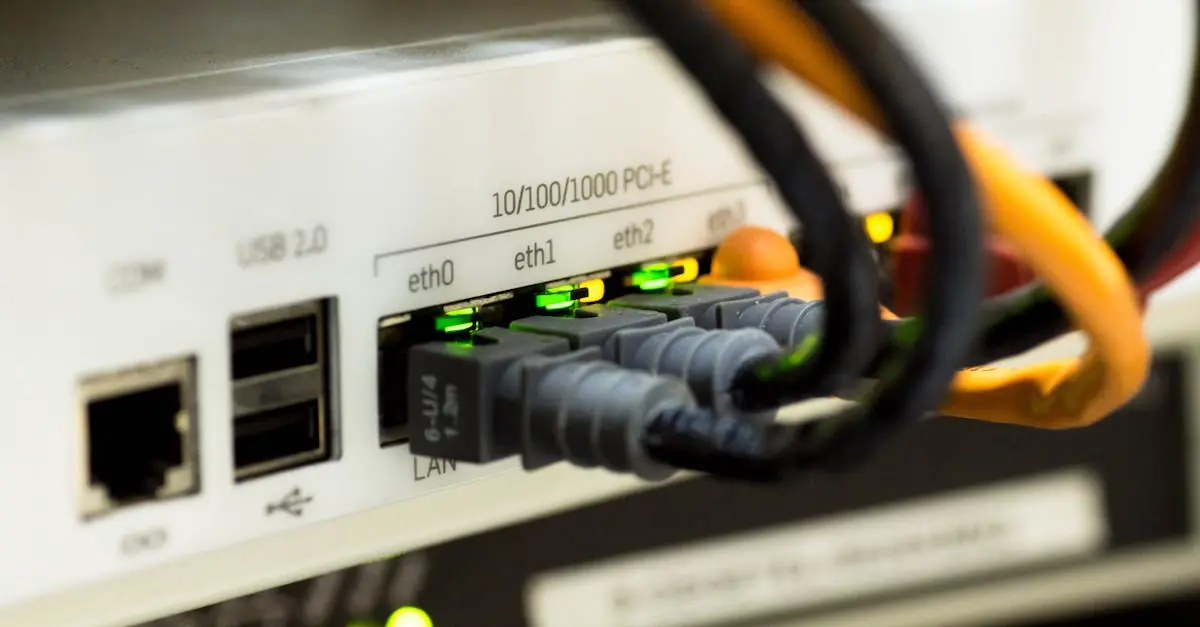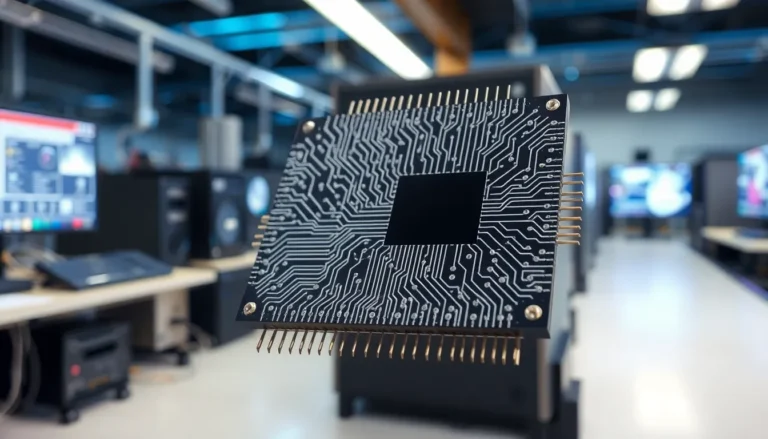In a world where your toaster can chat with your fridge, the Internet of Things (IoT) is no longer a futuristic dream—it’s today’s reality. IoT telecom takes connectivity to the next level, transforming everyday devices into smart gadgets that communicate seamlessly. Imagine a life where your coffee maker knows when you wake up and starts brewing your favorite blend before you even step out of bed. Now that’s a morning worth waking up for!
Table of Contents
ToggleOverview of IoT Telecom
IoT telecom integrates telecommunications and Internet of Things technologies, enhancing connectivity across various devices. This integration supports diverse use cases, including smart homes, healthcare, and industrial automation. The technology enables devices such as security cameras and smart thermostats to communicate in real-time, improving functionality and user experience.
Connectivity options in IoT telecom include LPWAN, 5G, and Wi-Fi. LPWAN offers low-power, wide-area capabilities ideal for devices that transmit small amounts of data. 5G provides higher speeds and lower latency, benefiting applications requiring immediate data transfer, such as autonomous vehicles. Wi-Fi remains a crucial player for many smart home devices, providing reliable short-range connectivity.
Data management plays a vital role in IoT telecom. Data collected from connected devices is transferred to cloud platforms for processing and analysis. This facilitates the development of insights and actionable information that businesses and consumers use to make informed decisions. Efficient data flow ensures optimal device performance and enhances the overall user experience.
Security measures in IoT telecom address vulnerabilities associated with increased connectivity. Implementing encryption, secure authentication, and regular software updates helps protect devices against potential threats. As IoT adoption continues to grow, maintaining robust security protocols remains a top priority for service providers.
IoT telecom combines telecommunications and IoT technologies, revolutionizing how devices communicate and operate. Through various connectivity options and data management strategies, IoT telecom enhances security and user experience across different sectors.
Key Components of IoT Telecom
IoT telecom encompasses essential elements that facilitate connectivity and communication among devices. Understanding these components reveals the framework supporting smart technologies.
Network Infrastructure
Connectivity relies on robust network infrastructure. Different technologies enable various applications, ensuring devices communicate efficiently. For instance, LPWAN serves low-power devices over long distances, while 5G offers high-speed connections for demanding applications. Wi-Fi provides flexibility for home and office environments. Each technology matches specific use cases, meeting performance requirements effectively. Network reliability ensures seamless interactions between smart home appliances, healthcare sensors, and industrial machines. Integrating these technologies creates a cohesive ecosystem for IoT deployment.
Devices and Sensors
Devices and sensors play a pivotal role in collecting data. They gather information from the environment, enabling real-time analysis and decision-making. Smart thermostats adjust heating based on user preferences, while wearable health monitors track vital signs continuously. With numerous devices in various sectors, compatibility and interoperability become crucial. Sensors must communicate with different platforms without issues. This interaction enhances functionality across ecosystems, allowing users to experience the full benefits of IoT telecom. Quality devices ensure accurate data transmission, which is vital for informed choices.
Benefits of IoT Telecom
IoT telecom offers numerous advantages that enhance the way devices connect and operate. These benefits include enhanced connectivity and improved efficiency in various sectors.
Enhanced Connectivity
Greater connectivity stands out as a primary benefit of IoT telecom. Devices communicate seamlessly via diverse networks like LPWAN, 5G, and Wi-Fi. Smart homes exemplify this capability, where security cameras and thermostats interact in real-time, allowing users to monitor and control their environment remotely. Additionally, integration across devices results in optimized user experiences, enabling automation that simplifies daily tasks. Businesses also reap the rewards, as connected devices streamline operations and foster quicker response times. Improved data exchange further enhances collaboration among connected devices, making enhanced connectivity essential for modern technological ecosystems.
Improved Efficiency
Efficiency improves markedly through the adoption of IoT telecom. Processes that once took substantial time now streamline thanks to real-time data transmission. Smart sensors collect data continuously, delivering insights that inform decision-making quickly. Industrial applications benefit particularly, as machinery can optimize performance, reducing downtime and maintenance costs. In healthcare, timely data availability leads to improved patient monitoring, which can result in better outcomes. Operational costs decrease as energy consumption becomes more manageable. Each sector experiencing these improvements gains a competitive edge, highlighting improved efficiency as a critical advantage of IoT telecom integration.
Challenges in IoT Telecom
IoT telecom faces several challenges that impact its effectiveness and broader adoption. Two significant areas of concern include security and scalability.
Security Concerns
Security plays a critical role in IoT telecom, as numerous connected devices create potential vulnerabilities. Each device represents a possible entry point for cyberattacks. Encryption is essential for protecting data transmission between devices and servers. Regular software updates help patch known vulnerabilities. Security protocols must adapt continually to counter evolving threats. Devices, especially those in sensitive sectors like healthcare, require robust authentication measures to prevent unauthorized access. Securing the entire ecosystem relies not only on effective technology but also on user awareness regarding potential security risks.
Scalability Issues
Scalability presents another challenge in IoT telecom deployments. As demand for connected devices grows, networks must efficiently accommodate this increase. Limited infrastructure can lead to network congestion, impacting performance. Different applications require distinct levels of connectivity, which complicates scalability. Providers must invest in flexible solutions capable of handling varying loads. In addition, managing a large number of devices requires advanced data processing capabilities. Ensuring systems can scale without compromising reliability or speed remains a priority for telecom operators.
Future Trends in IoT Telecom
IoT telecom continues to evolve with several promising trends anticipated to shape its landscape.
5G Integration
5G integration revolutionizes IoT telecom by providing faster data speeds and increased device connectivity. This technology supports a significant number of devices per square kilometer, enhancing urban environments and industrial applications. Low latency plays a crucial role; it enables real-time communication between devices, which is vital for applications like autonomous vehicles and remote surgery. Additionally, industries benefit from improved operational efficiency through the immediate transfer of data, leading to better decision-making processes. The expansion of 5G networks accelerates the adoption of smart technologies across various sectors.
Edge Computing
Edge computing enhances IoT telecom by processing data closer to the source, reducing latency and bandwidth usage. By utilizing localized data processing, devices can respond swiftly to changes in their environment, making security systems and smart appliances more efficient. This technology alleviates the strain on cloud resources, ensuring better system performance as demand for connected devices increases. Moreover, it supports critical applications in healthcare by facilitating quick data analysis from wearable devices. Scalability improves as organizations can manage growing data traffic more effectively, adapting to future IoT advancements seamlessly.
The evolution of IoT telecom is reshaping how devices connect and interact in everyday life. As technology advances with solutions like 5G and edge computing, the potential for seamless communication and enhanced efficiency grows exponentially.
While challenges like security and scalability remain, the focus on robust infrastructure and data management is paving the way for a more connected future.
Ultimately, IoT telecom stands as a transformative force, driving innovation across various sectors and improving user experiences. The journey ahead promises exciting developments that will further integrate and elevate the capabilities of connected devices.




